PART I—
THE FIRST ILLUSTRATED COPIES OF THE GRANDES CHRONIQUES
Chapter One—
Philip III's Grandes Chroniques
Contemporary Representations of Kingship at the Court and the Abbey of Saint-Denis:
Precedents for the Grandes Chroniques
Dionysian and courtly commissions, rather than other vernacular histories, provide precedents for the cycles of decoration in the earliest copies of the Grandes Chroniques de France . In view of the origins and patronage of the translation of the chronicle, this is not surprising. Because the French translation of the Latin chronicles of Saint-Denis began during Louis IX's reign, the earliest manuscript (Ste.-Gen. 782) must be considered with other commissions focusing on kingship that were produced for the saintly king and his successors. Further, because the text of the Grandes Chroniques was translated by Primat, a monk of Saint-Denis, and the illustrations of the presentation manuscript were probably planned with the advice of Primat or Abbot Matthew of Vendôme, the pictorial cycles in the earliest Grandes Chroniques de France are analogous to those commissions by the abbey or the court under the supervision of the abbey. The pattern of courtly and monastic commissions in the late thirteenth and early fourteenth centuries demonstrates how depictions of kingship were shaped by patronage and colored by self-interest.
Kingship in the Royal Context
The fortunes of the Capetian house flourished during the late thirteenth and early fourteenth centuries. When the first copy of the Grandes Chroniques was decorated shortly after the death of Louis IX in 1270, the Capetians were in firm control of France. By the reign of Philip the Fair (1285–1314), France was the dominant power in Europe, able to challenge and defeat even the pope. Although the last Capetians, Louis X (1314–16), Philip V (1316–22), and Charles IV (1322–28), were troubled by a dearth of male heirs, the institution of the monarchy remained powerful.[1]
Popular commissions responded to the concerns of the reigning king. Before Saint Louis, references to French kingship were couched most frequently in terms of the biblical antecedents of the French monarchs, the kings of Judah.[2] Depictions of kings from the Old Testament mingled with those of queens and prophets in jamb statues, such as those at Saint-Denis and Chartres; later, sculpted
Old Testament kings predominated in the galleries on the facades of cathedrals.[3] Galleries of kings may have been more explicitly dynastic; as early as the thirteenth century, literary references document the popular perception that the statues in the gallery of Notre-Dame represented kings of France.[4]
Ceremony and art dealing more specifically with the king also associated biblical with French kingship. One of the most important ceremonies to do this was the French coronation, versions of which were drafted around 1230 and again around 1250.[5] The sculpture of Reims cathedral, the site of the royal coronation, commemorates in more durable form the equation of Old Testament and French rulers expressed in the words of the coronation ceremony. Thus on at least one level, the interior facade of Reims is, as Sadler has shown, a collection of biblical exempla directed to the newly crowned king.[6]
Pictorial programs focusing on kingship evolved during the reigns of the last Capetians. Early commissions executed for Louis IX continued to portray kingship in terms of Old Testament models. For instance, artists depicted biblical scenes in a group of Parisian monuments in manuscript and stained glass executed for Louis. These emphasized human rather than divine action and concentrated primarily on Old Testament kings.[7] The changed subject matter and new narrative style in these cycles invested religious history with a "new prescriptive force" to become an example for royal behavior.[8] After Louis's canonization in 1297, hagiographic programs, frequently presented within a dynastic framework, became more common at court.[9] The presence of a royal saint allowed subsequent rulers such as Philip III or Philip the Fair to glorify the royal house by promoting the cult of their saintly forebear.[10]
During the reign of the last Capetian kings, royal commissions, whether biblical, hagiographic, or dynastic, manifested concern with legitimacy and dynastic continuity.[11] Increasingly, courtly commissions emphasized the continuous succession of the three races of French kings, a succession whose length and holiness, confirmed by the sainthood of Louis IX, were the subject of the Grandes Chroniques de France .
Kingship in the Dionysian Context
Throughout the late thirteenth and early fourteenth centuries, the fortunes of the abbey of Saint-Denis were closely connected to those of the Capetian kings.[12] As early as the twelfth century, Abbot Suger succeeded in weaving together the destinies of France and the abbey. He acted as regent while Louis VII was on crusade; secured the privileges of guarding the coronation regalia and the oriflamme , the official standard of the French kings; and established the abbey as the burial place for France's rulers.
Subsequent abbots followed Suger's lead in promoting Dionysian involvement in France and the king's involvement in the abbey. Abbot Matthew of Vendôme (1258–86) acted as regent when Louis IX was on his second crusade and handled the day-to-day administration for Louis's successor, Philip III.[13] Perhaps at the request of Louis, this same abbot gave visual expression to the abbey's role as royal necropolis by commissioning an extensive tomb program.[14] The deliberate interweaving of abbey and realm continued during the tenure of Giles of Pontoise (1304–26). He had been sponsored for the abbacy by Philip IV, had
acted as a royal councillor, and was an executor of Philip's will. In his commissions Giles of Pontoise continued the long-standing tradition of presenting the French ruler with objects that glorified his kingship and demonstrated the special role of the abbey in royal history.[15] Throughout this period the abbey's royal programs seem to have had a consistent aim: to combine self-promotion with promotion of the royal house. Programs aimed at a larger audience as well as those geared to a single viewer, the king, demonstrate this consistency of purpose.
Two Dionysian commissions of the late thirteenth and early fourteenth centuries exemplify this merging of self-promotion and royal promotion in the abbey's patronage. The program of tombs completed by Matthew of Vendôme in 1267 glorified kingship but also aimed to secure the rights of Saint-Denis over private foundations like Royaumont as the burial place for French kings.[16] Similarly, the presentation copy of Ivo of Saint-Denis's Vita et Passio Sancti Dionysii (B.N. fr. 2090–92 and B.N. lat. 13836), commissioned during the reign of Philip IV by Giles of Pontoise and given to Philip V around 1319, combined a vita of Saint Denis with a chronicle stressing his miraculous interventions in French history. This text was intended to reawaken royal devotion to Saint Denis as much as to promote kingship.[17]
Although these commissions consistently promoted the abbey, their portrayal of kingship and their dynastic content developed over time. The arrangement of tombs changed after the death of Louis IX and again after his canonization, evolving away from the original schematic demonstration of the origins of the Merovingian, Carolingian, and Capetian kings of France and their relationships to one another. The addition of a gilded tomb for Louis IX sometime before May 1282 affirmed his importance, as did Philip IV's directive in 1306 that the bodies of four Carolingian rulers and Philip III and Isabella of Aragon be moved to make room for his own tomb next to that of Saint Louis. In the process the tombs' program shifted from celebrating the succession of dynasties to concentrating on Louis IX, France's holy king.[18] Similarly, when the presentation copy of Ivo of Saint-Denis's Vita et Passio was prepared for Philip V, its text was translated and miniatures were added to reflect the special importance dynastic themes held for Philip.[19] Similar royal and Dionysian preoccupations influenced the development of cycles of the Grandes Chroniques .
The Copy of the Grandes Chroniques
Presented to Philip III:
A Mirror of Princes
The earliest surviving Grandes Chroniques (Ste.-Gen. 782) is a luxurious manuscript commissioned around 1274 by the monks of Saint-Denis for presentation to Philip III, who had succeeded his father, Louis IX, in 1270.[20] It contained the newly translated vernacular version of the chronicles of Saint-Denis and 36 miniatures and historiated initials. Parisian artists who had undertaken commissions for Louis IX decorated the book.[21] Any analysis of its cycle of decorations must consider these circumstances of production.
Such an analysis must also consider the hierarchy of decoration, the scale and positioning of miniatures in relation to one another, and the relationships between text and illustration. Such an approach refines previous interpretations
and shows that the content of the pictures in this chronicle is closer in tone to contemporary Dionysian cycles than to royal cycles commissioned by Louis IX or Philip III.
The iconography of Philip III's Grandes Chroniques is particularly inventive. Although the pictures in this new text employ diverse models, they transformed them into a focused program. For instance, a compositional pattern for a battle scene employed as a shop model in the stained glass of Saint-Denis (for the capture of Nicaea by the crusaders) and of Chartres (for the capture of a Spanish city) was adapted to represent Philip Augustus's capture of Le Mans (fol. 295).[22] In this case, the adaptation does not seem to have influenced the content of the scene. Parisian artists who worked in varied media used this model to represent any number of battles.
Some pictorial models may, however, have been more closely tied to their original texts. The clearest example of this is the Dream of Charlemagne (see Fig. 5), which illustrates a portion of the Grandes Chroniques translated from the chronicle of Pseudo-Turpin. The two scenes chosen for Philip III's manuscript are similar to those selected for such early monuments based on the text of the Pseudo-Turpin chronicle as the thirteenth-century châsse of Charlemagne at Aix-la-Chapelle. As in the Grandes Chroniques , this image combines the vision of the starry sky with the appearance of Saint James. The illustration of Saint James appearing to Charlemagne in the beginning of the Latin Pseudo-Turpin chronicle in the twelfth-century Codex Calixtinus and its fourteenth-century copies is also similar.[23] Although these earlier monuments form part of a rich visual tradition based on the Pseudo-Turpin chronicle—a tradition within which the image in Philip III's Grandes Chroniques belongs—the precise relationship between the illustration in the Grandes Chroniques and the earlier tradition is difficult to establish. Because the events represented in each image are described in both the Pseudo-Turpin chronicle and the Grandes Chroniques , the similarities between the châsse, Codex Calixtinus , and the Grandes Chroniques may be coincidental.[24] Artists may have arrived at their visual formulations independently.
The most sophisticated use of models in the Grandes Chroniques occurs in the adaptation of imagery from one text to illustrate another, as in the frontispiece of the chronicle. The first chapter of Book I of the Grandes Chroniques concentrates on tracing the genealogy of the French from Francion, the mythical son of Hector whose descendants founded France, whereas the picture that illustrates it concentrates on the rape of Helen. The beginning of the genealogy, which describes how Priam, ruler of Troy, sent his son Paris to Greece to avenge a slight committed by the Greek king, provided an opportunity to insert the frontispiece: Paris's vengeance was the abduction of Helen. The text of the chronicle goes on to describe the siege and destruction of Troy by the outraged Greeks and to tell how the few survivors of the city scattered all over the world.[25]
Only the first part of this brief Trojan account is illustrated in the frontispiece (Fig. 1). In four scenes the miniature portrays Priam dispatching Paris, Paris setting sail for Greece, Paris and his army capturing Helen in the temple of Venus, and the Trojans setting sail for Troy with their prize.
The picture offers more information than does its text because it was derived from another source, the Roman de Troie , written in the 1160s by Benoît de Sainte-
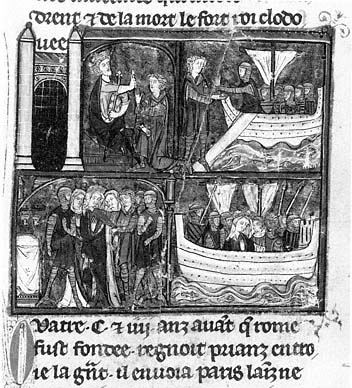
Figure 1
Priam dispatches Paris to Greece; Paris sets sail; Paris captures
Helen at the Temple of Venus; Paris and Helen set sail for Troy.
Grandes Chroniques de France . Bibliothèque Sainte-Geneviève,
Ms. 782, fol. 2v. Photograph: Bibliothèque Sainte-Geneviève, Paris.
Maure.[26] The earliest surviving Roman de Troie (Fig. 2), a provincial manuscript dated 1264, near the time of the execution of the Grandes Chroniques , presents the closest analogies with the chronicle's frontispiece.[27] These miniatures share three of four scenes; they differ only in the last frame, where the chronicle's picture substitutes the departure of Paris, Helen, and the Trojan army for the Roman de Troie 's scene of the massacre in the temple that preceded the Trojan flight from Greece.
This major change and certain subtle alterations to the miniature of the rape of Helen minimize the unjust behavior of France's Trojan ancestors and thus make them more appropriate models for Philip III. The rape of a queen and the slaughter of innocent, albeit pagan, worshippers were not exemplary modes of behavior. However, these scenes were often paired and graphically illustrated in early cycles of the Roman de Troie and in their adaptation in the Histoire ancienne .[28] By contrast, the rape in the Grandes Chroniques could almost be a wedding; the
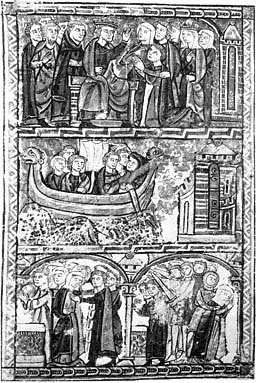
Figure 2
Priam dispatches Paris to Greece; Paris sets
sail; Paris captures Helen at the Temple of
Venus; Massacre of Greeks. Roman de Troie .
s'Heerenberg, Stichting Huis Bergh.
figures stand before an abbreviated altar in the presence of handmaidens and soldiers. The only suggestion of coercion in the image is Paris's firm grasp on Helen's wrist. Similarly, although it might be argued that the departure from Greece was added to round out the story, the scene was also appealing because of its nonviolent content. Both the text of the Grandes Chroniques and many later frontispieces go beyond the departure from Greece to offer a graphic depiction of the Greeks' revenge on Troy.
Despite their diverse origins, the illustrations of the first Grandes Chroniques form a carefully constructed program, one so particular to its time and place that the images had little influence on subsequent pictorial cycles. This Grandes Chroniques was produced for a specific audience; its miniatures reflect the historical preoccupations of the abbey of Saint-Denis, where it was commissioned, and provide certain models of kingship for Philip III, to whom it was presented.
Like the illustrations, two textual elements of this Grandes Chroniques support its special purposes. The French poem and prologue bracketing Philip III's book
present the Grandes Chroniques as a collection of exempla that follow the sequence of the three great French ruling houses in an effort to educate the young king Philip to be a good ruler. According to the prologue, the chronicle is to be a "mirror of life" in which "each person can find good and evil, beauty and ugliness, sense and folly, and profit in everything through the example of history."[29]
And because there have been three generations of kings in France since it all began, this history will be divided into three principal books: where the first will speak of the generation of Meroveus, the second of the generation of Pepin, and the third of the generation of Hugh Capet. Each of these books will be subdivided into diverse books, according to the lives and deeds of diverse kings; ordered by chapters to understand the material more easily and without confusion. The beginning of this history will be taken at the noble line of the Trojans from whom it [the French line] is descended by long succession.[30]
At the end of Philip III's Grandes Chroniques a special French poetic colophon, rarely copied in later manuscripts, addresses Philip directly.[31] Developing one theme sounded in the prologue—that of learning from the deeds of prior kings—it informs Philip that the manuscript was made for him to study and read in the hope that he would be a wise king. According to the poem, Philip should emulate the deeds of the good kings recorded in the chronicle and shun the example of the bad.
In their focus on the education of a young ruler these passages tie the chronicle to a newly forming tradition, the Mirror of Princes, a genre of political literature that remained popular throughout the Middle Ages.[32] Although Mirrors of Princes took varied forms, ranging from poetry to scholastic prose, they shared a royal audience and a content designed to teach a prince to govern with sound moral principles. The Capetian court of Louis IX, which probably provided the impetus for the translation of the Grandes Chroniques , played an important role in generating and consuming this type of political literature.[33] Indeed, the prologue and poetic colophon establish a reading of the chronicle that is consistent with our knowledge of Louis IX's use of history; Joinville, one of Louis's biographers, describes how the king told his children stories of past rulers to give them examples to follow and avoid.[34]
The miniatures of presentation that illustrate the prologue and poetic colophon frame the cycle of pictures in this manuscript and work with their texts to establish how the book should be read. In the first picture (Fig. 3), a kneeling monk humbly presents the chronicle to the king. The second picture (Fig. 4), the largest in the manuscript, transforms the presentation that inaugurates the chronicle, just as the poetic colophon elaborates themes presented in the prologue. In this two-column miniature the king is still enthroned and in his regalia, and Primat still presents his book, but Matthew of Vendôme rather than the king dominates the scene. Supervising the presentation, the imposing abbot stands so tall that the king must look up at him, and he and his monks occupy two-thirds of the picture's space. This miniature calls attention to the giving of the gift rather than its reception, and it suggests that the voice in the poem below it is Matthew's.[35] In doing so it celebrates the abbot's role in guiding Philip III and the important historiographic work done by Matthew of Vendôme and his monks.
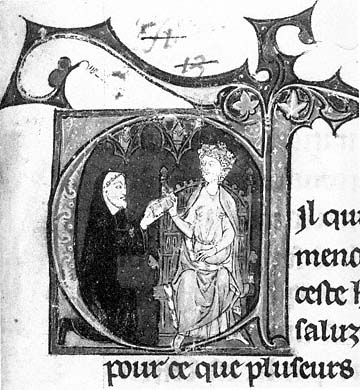
Figure 3
Presentation of book to Philip III. Grandes Chroniques de France .
Bibliothèque Sainte-Geneviève, Ms. 782, fol. 1.
Photograph: Bibliothèque Sainte-Geneviève, Paris.
The distribution of miniatures in the chronicle proper does not follow the simple pattern established by the textual divisions. Primat's translation of the Latin chronicle is laid out as a series of books, all but one of them (the life of Louis VII) preceded by chapter lists: five books tell of the Merovingians and of Pepin (the first Carolingian); five books recount the exploits of Charlemagne; two describe Charlemagne's first two descendants—Louis the Pious and Charles the Bald; one records the lives of the later Carolingians and of the Capetians up until Louis VI; one each is dedicated to Louis VI and Louis VII; and three report the deeds of Philip Augustus.[36]
The miniatures in Philip III's manuscript are of two types. Larger, columnwide miniatures mark the beginnings of books describing the lives of the Merovingian rulers, the imperial Carolingians (Charlemagne, Louis the Pious, and Charles the Bald), and Philip Augustus. Smaller historiated initials decorate books and chapters that Matthew of Vendôme must have perceived as less important to Philip III—those that record the lives of the last Carolingians and all Capetian rulers except Philip Augustus. Illustrations break this basic pattern in three places: small historiated initials pick out two chapters at the end of the last
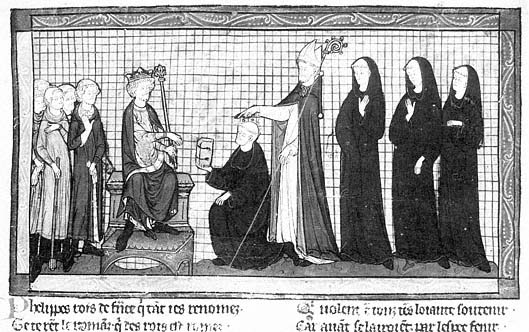
Figure 4
Presentation of book to Philip III. Grandes Chroniques de France . Bibliothèque Sainte-Geneviève,
Ms. 782, fol. 326v. Photograph: Bibliothèque Sainte-Geneviève, Paris.
Merovingian book, subdivide chapters in the lives of the last Carolingians, and mark the beginning of the chapter list in the life of Philip Augustus.
All these illustrations emphasize certain themes from the prologue of the Grandes Chroniques . Some, like the Trojan frontispiece and representations of good kingship in the lives of Charlemagne and Philip Augustus, are appropriate for the "Mirror" theme mentioned in the poem and prologue. Others relate more closely to the dynastic frame, the succession of races, also described in the prologue. Still others intertwine the histories of France and the abbey of Saint-Denis. As will become clear, all these themes are interdependent, so that the pictures weave together the textual themes of good kingship, dynastic continuity, and historical identity between France and Saint-Denis.
Models of Kingship
The Trojan frontispiece and the subcycles of the lives of Charlemagne and Philip Augustus shed light on the ideals of kingship promoted in the Grandes Chroniques given to Philip III. A comparison of the frontispiece with its probable model and of the illustrations of the lives of Charlemagne and Philip Augustus with the subsequent tradition helps to pinpoint consistent aims in the cycle.
As discussed earlier, the frontispiece of the first copy of the Grandes Chroniques emphasizes the Trojan ancestry of the French kings. With certain care-
ful modifications, it copies the most modern visual source for the story to show the ancestors of the French kings as suitable models for kingship.
Pictures illustrating the life of Charlemagne provide similar models. Except for its opening miniature, the subcycle of the life of Charlemagne resembles early cycles of his life based on the Pseudo-Turpin chronicle and is typical of later cycles in the Grandes Chroniques .[37] Nonetheless, the repetition of the figure of Charlemagne in scenes from his life attracts the reader's attention. Thus the dream of Charlemagne encompasses two scenes (Fig. 5): in one the king first sees the vision of the starry road, and in the other Saint James appears to explain it to him. In the miniature of Charlemagne's coronation (Fig. 6) two images invert the relationships between the emperor and the pope. In the upper scene the church is supreme, and Charlemagne kneels to be crowned emperor in Rome at the hands of the pope; in the lower scene the state takes priority, and the pope pleads with Charlemagne to commute the sentences of those condemned by the emperor for degrading the pontiff.
Although these scenes derive directly from the chronicle's text, they depart from it in one important visual detail—they emphasize Charlemagne's kingship
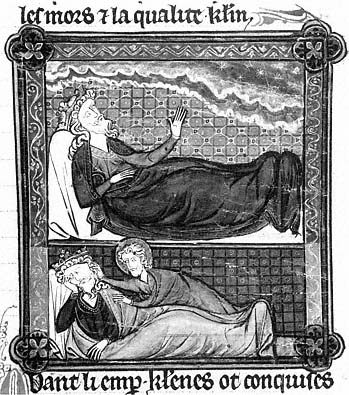
Figure 5
Charlemagne has vision of the starry sky; Saint James
appears to sleeping Charlemagne. Grandes Chroniques
de France . Bibliothèque Sainte-Geneviève, Ms. 782, fol.
141. Photograph: Bibliothèque Sainte-Geneviève, Paris.
rather than his imperial status. Only the miniature of Charlemagne's coronation as emperor includes an imperial crown.[38] Its absence in subsequent miniatures is curious yet may be explained by the historical relationship of the French kings to the empire.
These pictures express a nationalistic tradition that held that Charlemagne was an important model of French kingship.[39] Until the twelfth century Charlemagne was viewed as ancestor of the West Frankish, or French, kings, but not as progenitor of the German rulers who became associated with the Holy Roman Empire.[40] With the exception of the German emperor, Frederick Barbarossa, who sponsored the canonization of Charlemagne in 1165, few Germans felt a popular sentiment for Charlemagne. In France, on the other hand, Charlemagne was immensely popular in both Dionysian and royal circles. As early as the twelfth century, the abbey of Saint-Denis employed numerous devices to tie itself to the growing cult of Charlemagne.[41] A forged charter suggested that Charlemagne had paid homage for France at the abbey. The monks mounted a campaign to promote the oriflamme , guarded at Saint-Denis, as Charlemagne's personal standard. This propaganda was effective and spread into vernacular chansons de geste , like the
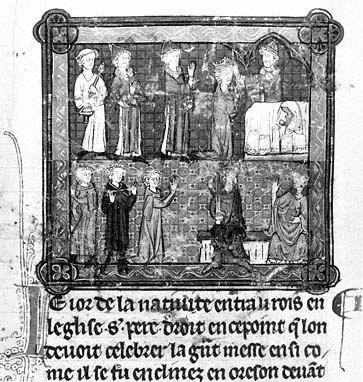
Figure 6
Pope Leo III crowns Charlemagne at Rome; Pope and emperor
judge conspirators. Grandes Chroniques de France .
Bibliothèque Sainte-Geneviève, Ms. 782, fol. 121v.
Photograph: Bibliothèque Sainte-Geneviève, Paris.
Pilgrimage of Charlemagne , which celebrated Charlemagne's fictitious trip to the East from which he brought back relics allegedly given later to Saint-Denis by Charles the Bald.
By the reign of Philip Augustus a cult of Charlemagne flourished in France, focusing on Charlemagne as emperor. It was employed primarily to justify territorial expansion.[42] In the popular imagination, reflected in chansons de geste of the twelfth and thirteenth centuries, Charlemagne's empire was equated with the kingdom of France: 170 passages in the chanson de Roland make this equation.[43]
In the late thirteenth century, when this manuscript of the Grandes Chroniques was produced, the association of France with the empire and the French king with the emperor seems to have had a different use. Despite, or perhaps because of, a botched attempt to secure the imperial crown, Philip III placed more emphasis on defining the limits of French kingship than on claiming the empire.[44] Political texts produced during his reign consistently underscore the French king's sovereignty—he is princeps in regno suo who "takes his power from no one except God and himself" (le roy ne tient de nului fors de dieu et de lui )—without any reference to the empire.[45]
The identification of the French king with Charlemagne in a ceremony described in the Grandes Chroniques further strengthened French kingship. Philip was the first king to use Charlemagne's sword, Joyeuse , in the ceremony of coronation, thus emphasizing Charlemagne's role as ancestor of the French kings.[46] Certainly, the portrayal of Charlemagne as a French king in the illustrations of Philip III's Grandes Chroniques was deliberate and, moreover, compatible with his consistent political posture.
Illustrations of the life of Philip Augustus are equally important in this manuscript, both as models of kingship for Philip Augustus's namesake and possibly as a further means of associating Philip III with Charlemagne. The hierarchy of decoration in the manuscript, as well as one particularly powerful miniature, mark this segment of the text with a special subcycle.
A historiated initial of the king enthroned begins the chapter list, and three miniatures illustrate the life of Philip Augustus. Only Philip Augustus's life has a historiated initial mark the chapter list, and miniatures rather than historiated initials illustrate the account of his reign—the first in the manuscript since the histories of the early Carolingians. Doubtless Philip Augustus alone of the Capetians receives such attention in part because he held a special place in the thoughts of Philip III. Philip Augustus was presented along with Saint Louis as a model for Philip III, as, for instance, in the dedication verses to Guillaume de Nangis's Life of Saint Louis .[47] Other writings from the thirteenth and fourteenth centuries describe Philip Augustus as one of the first of a series of holy kings to rule France.
The first miniature of Philip Augustus's life (Fig. 7) suggests this king's holiness and miraculous birth: Christ swoops down from behind a cloud to present a young crowned king to Louis VII and his wife, who kneel in prayer with representatives of a cross section of society. This image is more emblematic than narrative. Instead of illustrating Louis VII's Christological vision (Philip Augustus giving the barons blood to drink from a chalice) or the actual birth of an heir—images that became canonical illustrations for this text in later copies of the Grandes Chroniques —this miniature focuses on Philip's sobriquet, Dieudonné . The picture derives from the text of the chronicle but combines Louis VII's prayer with its
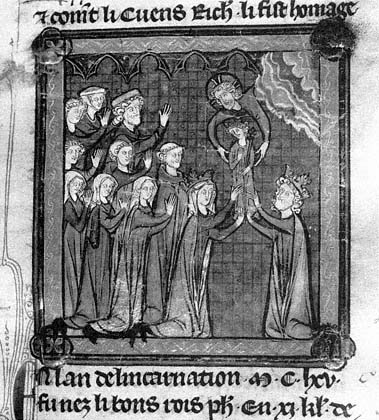
Figure 7
Louis VII and Queen Alix receive Philip Augustus from Christ.
Grandes Chroniques de France . Bibliothèque Sainte-Geneviève,
Ms. 782, fol. 280. Photograph by the author.
response. The text describes how the king, his queen, and all the clergy and people of the realm prayed for the birth of a son. God heard their prayers and gave them Philip, a son whom Louis "nourished healthily and introduced plainly in the faith of Christ and the commandments of the holy church" and whom he had crowned at Reims when he was "of appropriate age."[48]
The portrayal of Philip as a crowned child holding a scepter contradicts part of the narrative; he was not crowned until he was 14 years old. Indeed, Philip's dress alludes to Louis VII's prayer, also recorded in the chapter, in which Louis requests an heir to rule: "Lord, give me a son, heir of my body, noble governor of the realm of France."[49] This boy clad in the attributes of kingship comes in answer to the prayer of the king and the populace for a "governor." The picture thus celebrates both the birth of Philip Augustus and the God-given kingship of France.
In this manuscript Philip Augustus and Charlemagne not only provide Philip III with distinct models for French kingship, but are also associated with
each other. This connection is emphasized by the layout of the cycle of decoration. A reader coming upon the group of miniatures illustrating the life of Philip Augustus might well recall that Charlemagne was the last ruler in this manuscript to have such a cycle.
Textual evidence provides further reasons for associating Philip Augustus with Charlemagne. The most famous text to do so is the reditus regni ad stirpem Karoli Magni , the prophecy that seven generations after the usurpation of the French throne by Hugh Capet, France would be returned to a ruler of Carolingian descent.[50] In this copy of the Grandes Chroniques , discussion of the reditus is limited to a small paragraph at the beginning of Hugh Capet's life which states that Philip Augustus married Elizabeth of Hainaut expressly to recover the line of Charlemagne.[51] In later copies of the chronicle an expanded discussion of the reditus appears at the beginning of the life of Philip Augustus's son, Louis VIII, who fulfilled the prophecy because he was descended from the Carolingians on both his mother's and father's sides.[52] Perhaps because Louis's life was not included in Philip III's manuscript, Philip Augustus is presented as the prime agent of the reditus .
The reditus affected Primat's translation of his sources. In describing the second coronation of Philip Augustus, which took place in Saint-Denis in 1180 during his marriage to Elizabeth of Hainaut, Primat transformed his Latin source, a text by Rigord, by explicitly referring to Charlemagne. The Latin text described how Elizabeth's uncle, Philip of Flanders, carried a sword with honor before the king; Primat's version speaks of "Philip of Flanders, who on this day carried Joyeuse , the sword of the great king Charlemagne, before the king as is right and customary at coronations of kings."[53]
These visual and textual references to Charlemagne and Philip Augustus are provocative because they may echo Philip Augustus's identification with Charlemagne, voiced most explicitly in the reditus . Primat's interpolation, moreover, may have been an attempt to establish a precedent for Philip III's use of Charlemagne's sword in his coronation and to strengthen the identification between Philip III and his great Capetian ancestor Philip Augustus. Mention of the sword Joyeuse was probably intended to recall Charlemagne, Philip Augustus's illustrious predecessor, and to refer to Philip III, his namesake who also used Charlemagne's sword in the ceremony. Thus both text and pictures present Charlemagne and Philip Augustus to Philip III as dual models of kingship.
Dynastic Continuity
Other illustrations in Philip III's Grandes Chroniques develop the dynastic theme of the prologue. These merge, yet differentiate, the sequence of Merovingian, Carolingian, and Capetian rulers that stretches back to Troy, and in the process they celebrate the legitimacy of the Capetians and of Philip III.
Two historiated initials break the pattern of illustrations in the first portion of the manuscript to address the transfer of government from Merovingian to Carolingian. The first (Fig. 8) portrays the coronation of Chilperic II, in a chapter that begins with a rubric, "Ci commence li fait du noble prince Charles Martel," which directs attention away from Chilperic to the mayor of the palace, Charles Martel. The second initial (Fig. 9) celebrates the prowess of Pepin, Charles Martel's
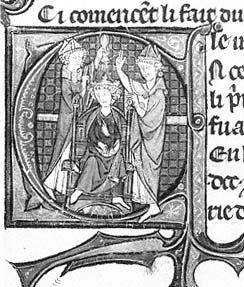
Figure 8
Coronation of Chilperic II. Grandes Chroniques
de France . Bibliothèque Sainte-Geneviève, Ms.
782, fol. 100.
Photograph: Bibliothèque Sainte-Geneviève, Paris.
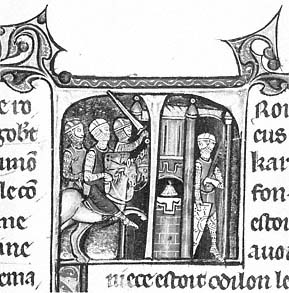
Figure 9
Carloman and Pepin capture Laon from their brother
Grifon. Grandes Chroniques de France . Bibliothèque
Sainte-Geneviève, Ms. 782, fol. 103.
Photograph: Bibliothèque Sainte-Geneviève, Paris.
son and the progenitor of the Carolingian line, shown with his brother capturing the city of Laon. The text describes how, as a reward for his nobility in defending the French realm, Pepin was crowned king of France by the pope, who noted the weakness of the last Merovingian rulers, whom he was deposing, and the strength of Pepin as true governor of the realm.[54]
A second, less explicit break of decorative pattern comes in the book dedicated to the lives of the last Carolingian and early Capetian kings. In this section historiated initials subdivide several chapters outlined in the chapter list. The clusters these form again imply that a transition of dynasties is a reward for good government. A sequence of scenes in one chapter creates a precedent for Capetian rule. In the first cluster (Fig. 10) Normans invade France because the Carolingian king, Charles the Simple, is too young and too weak to govern. In desperation the barons turn to the mayor of the palace, Odo Capet, and crown him king (Fig. 11). Odo governs but remains loyal to young Charles. As soon as Odo dies and the realm reverts to Charles the Simple, the political situation degenerates. The Normans invade again, only to be driven from the realm by the duke of Burgundy (Fig. 12). A second cluster of historiated initials represents the chaos that preceded Hugh Capet's accession to the throne. A sequence of three historiated initials shows the coronation of Louis V, the last Carolingian king (Fig. 13); the conflict between Louis's uncle, Charles, and Hugh Capet's army, which broke out because Hugh would not accept Charles's succession (Fig. 13); and the resolution of the crisis—Hugh Capet, descendant of Odo and, like Odo, mayor of the palace,
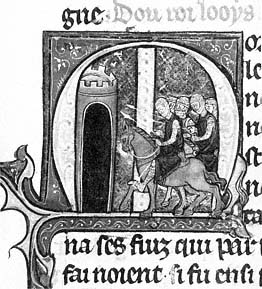
Figure 10
Invasion of the Normans. Grandes
Chroniques de France . Bibliothèque
Sainte-Geneviève, Ms. 782, fol. 208v.
Photograph: Bibliothèque Sainte-
Geneviève, Paris.
becomes king (Fig. 14). As the chronicle describes it, "because Hugh saw that all the heirs and the line of Charlemagne were destroyed and also since [the line] died out and since there was no one to contradict him, he had himself crowned in the city of Reims."[55] Hugh's life does not show his assumption of power but rather depicts him already crowned and exercising his kingly prerogatives, in this case pardoning the count of Flanders at the request of the duke of Normandy.
This handful of historiated initials promotes the idea that the French ruling house draws its legitimacy as much from just government as from blood. Such legitimacy can be confirmed by blood, as the reditus suggests, but it is not necessarily created by it.[56] This view seemed to be foremost at Saint-Denis from the 1260s to 1280s, for it shaped other commissions, including the large sculpted tomb program for the abbey church and the Latin guide to the tombs written by Guillaume de Nangis.[57] The combination of distinct lines unified by the reditus in the tombs and in the Latin Abbreviated Chronicle supports my interpretation of Philip III's program of decoration. All three—the tombs, the Latin chronicle, and the pictorial cycle of Philip III's Grandes Chroniques —trace the lines of office of the French king and note each spot where succession based on good government and succession based on blood diverge. But in each the careful documentation of genealogical discontinuity is secondary to the celebration of continuity of the long line of good governors. This continuity was confirmed by the reditus , which reunified legitimacy of blood with legitimacy of succession to office in the Capetian descendants of Philip Augustus.[58]
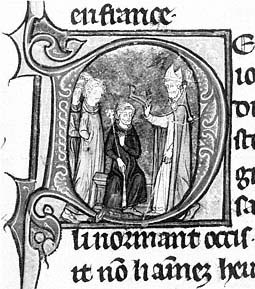
Figure 11
Coronation of Odo Capet. Grandes
Chroniques de France . Bibliothèque
Sainte-Geneviève, Ms. 782, fol. 208v.
Photograph: Bibliothèque Sainte-
Geneviève, Paris.
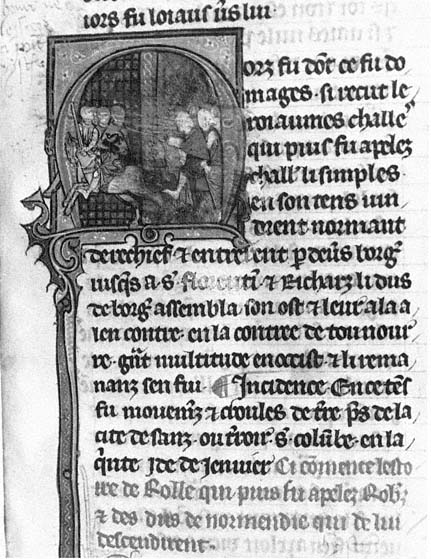
Figure 12
Normans driven from France by the duke of Burgundy. Grandes Chroniques de
France . Bibliothèque Sainte-Geneviève, Ms. 782, fol. 209. Photograph by the author.
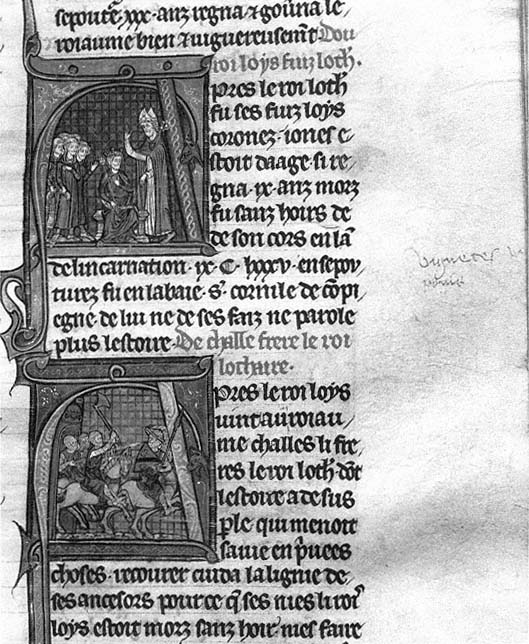
Figure 13
Coronation of Louis V; Army of Charles of Lorraine puts to flight that of Hugh Capet. Grandes
Chroniques de France . Bibliothèque Sainte-Geneviève, Ms. 782, fol. 219. Photograph by the author.
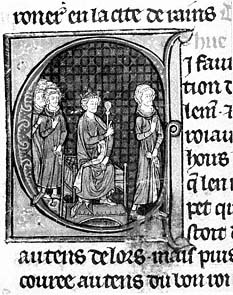
Figure 14
Hugh Capet pardons the count of Flanders.
Grandes Chroniques de France .
Bibliothèque Sainte-Geneviève, Ms. 782, fol.
219v.
Photograph: Bibliothèque Sainte-Geneviève, Paris.
The Royal House and the Abbey of Saint-Denis:
A Shared History
The impetus toward self-promotion characteristic of commissions sponsored by the abbey of Saint-Denis explains the presence of one rare miniature in this Grandes Chroniques . The illustration for the first book of the life of Charlemagne comprises two scenes (Fig. 15). In the lower register, Childeric III, the last Merovingian king, is deposed and forced to enter a monastery.[59] Above this scene Pope Stephen II crowns Pepin, the first Carolingian ruler. Perhaps in an attempt to feature the coronation at Saint-Denis in which the pope took part, the composition in this miniature inverts the narrative structure common to every other multitiered miniature, in which the story unfolds from left to right and from top to bottom. This is therefore a specially tailored image whose subject does not recur in any later cycles.[60]
Although dynastic interests account in part for the inclusion of the miniature of Pepin's coronation, the history of Saint-Denis may explain its prominence. Because the ceremony took place at Saint-Denis, it was as much a part of the history of the abbey that produced the text as it was of the king who received the manuscript.[61] The illustration of Pepin's coronation served as a reminder to the king of the intertwined history of the abbey and the French royal house.
Philip III's Grandes Chroniques is a carefully crafted text decorated by illustrations that clarify the chronicle's dynastic and Dionysian content. Primat's French
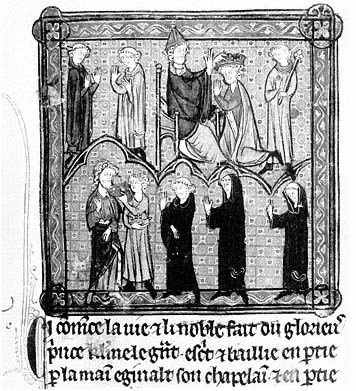
Figure 15
Pope Stephen II crowns Pepin; Childeric III deposed. Grandes
Chroniques de France . Bibliothèque Sainte-Geneviève, Ms. 782,
fol. 107. Photograph: Bibliothèque Sainte-Geneviève, Paris.
text is more than a translation from the Latin; Primat rearranged the structure of his Latin model to focus more attention on Charlemagne and Philip Augustus, and he appended a prologue and a poetic colophon that together shaped the text as a Mirror of Princes.
Pictures reinforce many of Primat's innovations. The historiated initial at the prologue and the large miniature at the end of the manuscript strengthen this interpretation of the text, and the density of the cycles and scale of illustration promote the importance of Charlemagne and Philip Augustus as royal models. In addition, miniatures betray the circumstances of the book's production, stressing the concerns with dynastic legitimacy, which were important to royalty, as well as the historical ties between the French crown and the abbey, which were so evident in Dionysian commissions. These observations may explain why this pictorial cycle spawned no progeny despite its presence in the royal library at the Louvre.[62] Because Philip's Grandes Chroniques was commissioned for a special audience at a particular time, its pictures tailor the reading of the text to suit the needs of both Philip III and the abbey of Saint-Denis.
Chapter Two—
Manuscripts Produced during the Reigns of the Last Direct Capetians
Manuscripts of the Grandes Chroniques produced during the reigns of the last Capetians are simpler in conception than is Philip III's book. Few have the precise didactic frame, the combination of prefatory prologue and poetic colophon, that Philip III's book has, and those that share Philip III's textual frame do not share its complex program of decoration.[1] Controlled, self-conscious versions of the chronicle such as Philip III's were in the minority in the late thirteenth and early fourteenth centuries. Pictures in most manuscripts from this era share only the simplest aspects of Philip III's program of decoration.
Parisian libraires working for members of the nobility supervised the production of the majority of surviving copies of the Grandes Chroniques from this period.[2] Perhaps as a result, cycles of decoration in these manuscripts do not seem to focus on exempla in the same way that the illustrations in the manuscript of Philip III do. Indeed, it is difficult to determine whether the pictures in many of these books were intended to shape a reading of the text. It is unclear whether the events highlighted by pictures were important to a specific patron, whether they were selected for him, or whether they were prepackaged by the editor before a patron arrived. Yet there are ways of coming to grips with the cycles in these manuscripts. Once the late Capetian manuscripts have been examined carefully, certain books reveal affinities with courtly and royal programs from the reign of Philip IV.
Genealogical Manuscripts
Libraires producing many of the Grandes Chroniques for the court adapted their illustrations to portray one of the many themes that shaped Philip III's manuscript: dynastic continuity. Taking their lead from the passage in the prologue that describes the "long succession" of French kings, they represent a royal genealogy that concentrates on succession to office rather than heredity.[3]
Two chronicles from the early fourteenth century (Cambrai, B.M. 682; B.N. fr. 2615) reveal the shape that such genealogical programs took. Although the provenance of these manuscripts is uncertain, textual and pictorial evidence links
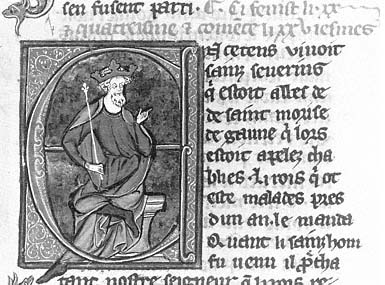
Figure 16
Clovis. Grandes Chroniques de France . Cambrai, Bibliothèque
Municipale, Ms. 682, fol. 19.
Photograph: Bibliothèque Municipale de Cambrai.
them to a courtly milieu. The chronicle in Cambrai includes the French and Latin dedication poems that appear in Philip III's Grandes Chroniques and in three later manuscripts, one of which belonged to Charles V. These textual features may indicate a royal recension of the text and suggest at the very least that the book was made for a person close to the king.[4] Artistic evidence places the second manuscript (B.N. fr. 2615) in a Parisian milieu.[5] Pictures in this chronicle relate stylistically to those by a group of artists who decorated books for the king and members of the nobility. On the basis of style, Avril dates the Grandes Chroniques in Paris to 1315–20, an attribution that is supported by a textual interpolation that provides a terminus post quem of 1315.[6]
In planning illustrations for these manuscripts, the libraires took their cue from the portion of the prologue that describes the genealogy of the French kings. The pictures repeat basic patterns, emphasizing enthroned rulers in the chronicle in Cambrai and coronations in the manuscript in Paris. The cycle from the Cambrai manuscript is the simpler. Its historiated initials, which mark normal divisions in the text, contain enthroned kings holding either swords or scepters, as for instance in the picture of Clovis (Fig. 16). The only deviation from the pattern occurs at the beginning of the third book of the life of Charlemagne (Fig. 17), where an emperor holds an orb and a scepter to commemorate Charlemagne's imperial coronation.
The cycle decorating the Paris manuscript is structured on the same principle but executed with greater sophistication. Coronations of almost every ruler of
France illustrate this book.[7] Their placement breaks down the customary structure of the text, which is normally divided into books subdivided into chapters. In this manuscript reigns of kings form textual units, and as a result the density of illustration varies radically. For instance, illustrations of the coronations of Louis III, Odo Capet, and Charles the Simple (fols. 140–141) break what normally constitutes the seventh chapter of the life of Louis the Stammerer into three segments. In other parts of the manuscript many folios separate miniatures. Thus the sequential miniatures illustrating the coronation of Louis the Pious as co-emperor by Charlemagne (fol. 90v) and the coronation of Louis the Pious as emperor (fol. 115) are 25 folios apart.
The iconography of the Paris book's cycle of illustration was carefully coordinated before the gatherings were given out to at least nine different artists.[8] Each scene incorporates details drawn from its text. Thus when the Grandes Chroniques lists three of the king's brothers attending his coronation, the miniature includes them.[9] The designer of the manuscript even elaborated the text on occasion by using elements drawn from conventions of representation to identify characters. For instance, the attributes used to distinguish Charles Martel (a large gold hat) and Pepin the Short (a lion under his feet) in the illustration of Charles Martel dividing his realm between Pepin and Carloman (Fig. 18) also appear in subsequent miniatures.[10] In the next folio Pepin is easily identified by his lion in the illustration of the coronation by Pope Stephen (Fig. 19).
These extratextual iconographic details occasionally promote the theme of dynastic continuity. Thus Pepin's and Charles Martel's costumes are used for their
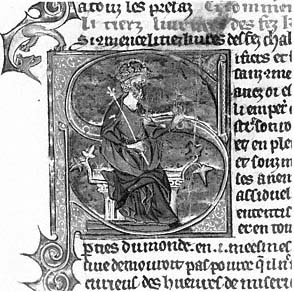
Figure 17
Charlemagne. Grandes Chroniques de France .
Cambrai, Bibliothèque Municipale, Ms. 682, fol.
140v.
Photograph: Bibliothèque Municipale de Cambrai.
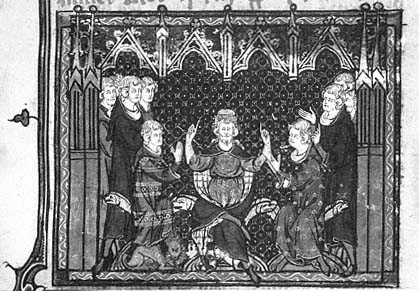
Figure 18
Charles Martel divides the realm between Pepin and Carloman.
Grandes Chroniques de France . Bibliothèque Nationale, Ms. fr.
2615, fol. 72. Photograph: Bibliothèque Nationale, Paris.

Figure 19
Coronation of Pepin by Pope Stephen II. Grandes Chroniques de
France . Bibliothèque Nationale, Ms. fr. 2615, fol. 72v.
Photograph: Bibliothèque Nationale, Paris.
descendants. When Charlemagne supervises the pope's coronation of his two sons, Pepin and Louis (Fig. 20), Charlemagne and Pepin dress like their namesakes. Charlemagne wears the gold hat of Charles Martel, and Pepin has a lion like Pepin the Short's at his feet.
Although scenes from the Paris Grandes Chroniques incorporate specific details drawn from the text, they are essentially nonnarrative, like the miniatures in the Cambrai manuscript. Both cycles are fundamentally different from that in Philip III's Grandes Chroniques . The repetition of enthroned kings or of ceremonies of coronation in these manuscripts focuses attention on the line of kings who governed France rather than on the exploits of certain rulers who were special models for kingship.
Such genealogical programs have parallels in secular and Dionysian commissions from the reigns of Philip the Bold, Philip the Fair, and his sons. These, like B.N. fr. 2615 and Cambrai, B.M. 682, also reject the reditus as a structuring principle for representations of dynastic kingship. The series of montjoies , or markers, erected on the road between Paris and Saint-Denis was an early and public example of such a dynastic program.[11] In place from the late thirteenth century, these monuments were identical in type: each was topped by a cross and decorated by fleurs-de-lis, and each contained three niches filled with generalized representations of French kings who varied in pose from one monument to the other. The cumulative effect of these monuments emphasized the length and strength of the French line. On a trip from Paris to Saint-Denis a traveler would have seen 21 to 27 kings.[12]
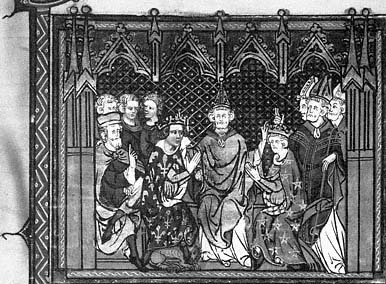
Figure 20
Charlemagne supervises coronation of Pepin and Louis. Grandes
Chroniques de France . Bibliothèque Nationale, Ms. fr. 2615, fol. 79v.
Photograph: Bibliothèque Nationale, Paris.
Royal commissions for Philip the Fair placed equal emphasis on his descent. The most notable courtly commission of this sort was the decoration of the Grande Salle of the Palais de la Cité under Philip IV. There a series of labeled polychromed statues portrayed French kings from Pharamond to Philip himself.[13] Contemporary descriptions make clear that these were perceived as commemorations of the office of king. In the 1320s Jean de Jandun described the statues in terms of succession to office: "For the honor of their glorious memory, the statues of all the kings of France who occupied the throne up to the present are gathered in this place. Their likeness is so expressive that at first glimpse one would believe they were alive."[14]
Philip IV's commissions at Saint-Denis also concentrated on royal succession rather than the sequence of dynasties or the reditus . In 1306 Philip IV ordered the tombs at Saint-Denis rearranged to move his and his parents' tombs to the Carolingian side of the choir. This change merged the division of ruling houses that had been so carefully established in the 1260s.[15] Although some scholars interpret the rearrangement as an attempt to place Philip III's and Philip IV's tombs close to that of their holy ancestor, Louis IX, it also blended the lines so that the overwhelming impression on a visitor to the abbey would be comparable to that of Jean de Jandun when he faced the sculpture of the Grande Salle of the Palais de la Cité.
Royal taste for the emphasis on the long line of kings eventually affected Dionysian commissions. During the reigns of Philip IV and his sons even the monks of Saint-Denis abandoned the reditus as a means of structuring royal succession. A telling example is the third portion of Ivo of Saint-Denis's Vita et Passio (B.N. lat. 13836), part of a manuscript commissioned by Philip IV but presented to Philip V c. 1319.[16] This book merged the histories of France and Saint-Denis by appending at the end of Saint Denis's vita a historical compilation decorated by pictures of enthroned kings woven into a genealogical framework that is much more explicit than that of any contemporary copy of the Grandes Chroniques .
Marginal notes in a 1330s version of the Vita et Passio preserved at the abbey of Saint-Denis (B.N. lat. 5286) contribute to a reconstitution of the pictorial program in the manuscript presented to the king.[17] Several of these notes refer to images in the king's book that present special models of kingship in Charlemagne and Saint Louis or stress the importance of the French house.[18] One image in particular could have been included in the king's book only for dynastic reasons. At the end of the folio on which Hugh Capet's life is described in the later copy (B.N. lat. 5286) preserved at Saint-Denis, a cursive note describes a chart that diagrams Hugh Capet's descent from the Carolingians.[19] Although references to the chart occur in the monastery's copy, it was included only in the king's version (Fig. 21).[20] There it reinforces the Latin and French rubrics to the chapter, thus confirming Hugh Capet's legitimacy as a Carolingian.[21] The inclusion of this chart in the illustrations of the kings of France that decorate the royal book presents the reader with a pictorial genealogy of the kings of France that, like those of the Grande Salle's sculptures and contemporary genealogical Grandes Chroniques , runs unbroken from Troy to Philip V, but presents continuity of blood as well as of succession.
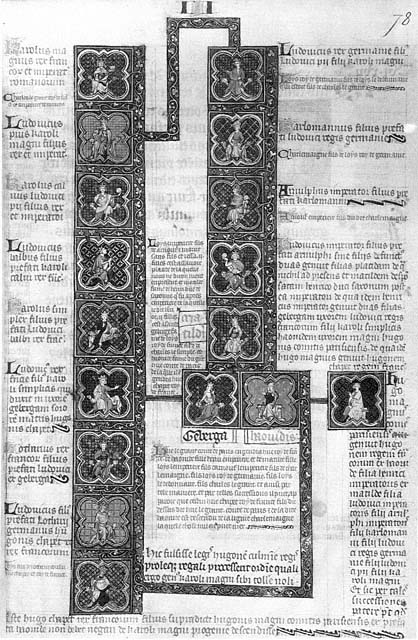
Figure 21
Genealogical tree for Hugh Capet. Ivo of Saint-Denis, Vita et Passio Sancti
Dionysii . Bibliothèque Nationale, Ms. lat. 13836, fol. 78.
Photograph: Bibliothèque Nationale, Paris.
Independent Traditions:
A Parisian Bookseller's Chronicle
One manuscript of the Grandes Chroniques (B.N. fr. 10132), probably finished in the 1320s and continued again in the mid-fourteenth century, illustrates the extent to which available models affected the form of cycles. This book was commissioned from Thomas of Maubeuge, a noted Parisian libraire , by Pierre Honnorez of Neufchâtel in Normandy.[22] Apparently Thomas based his manuscript on a copy of the Grandes Chroniques to 1223, which copies an exemplaire that seems to have circulated among Parisian booksellers until the early fifteenth century, and supplemented that text with Guillaume de Nangis's amplified chronicle for the lives of Louis VIII through Louis X.[23] To organize the text Thomas turned not to royal or courtly models of the Grandes Chroniques but to contemporary vernacular histories, specifically to the Abrégé de l'histoire de France by the Ménestrel of Alphonse of Poitiers, one of the texts whose prologue was adapted for the Grandes Chroniques .[24]
This copy of the Grandes Chroniques is the only one whose text follows the tripartite division outlined in the section of the prologue taken from the Ménestrel's chronicle and used to structure manuscripts of that text. Thomas of Maubeuge did as the derivative section of the Grandes Chroniques 's prologue mandates: he divided the history into three principal books that deal with the "generations" of Meroveus, Pepin, and Hugh Capet. To clarify the organization of the text further, Thomas provided a genealogically structured table of contents in the first gathering, which was added after the manuscript was completed through the life of Louis X. Besides listing certain important passages and noting the folios on which they appear, the chapter list explains how to use the text when it is divided into three: "And to know how to find the generation by the number, you will find in the first generation on each page the number .i., in the second .ii., and in the third .iii. And thus you will find the things which are there."[25] Within each of the subdivisions of the text proper the pagination begins anew.
The earliest manuscripts of the Abrégé de l'histoire de France , dating from the thirteenth century, append genealogical trees that function like Thomas's genealogically ordered chapter list.[26] These diagrams distinguish the Merovingians, Carolingians, and Capetians from one another so clearly that few other illustrations are needed.[27] As a result, the Abrégé provided few pictorial models for Thomas. The textual relationship between these books therefore makes the independence of Thomas's illustrations even more noteworthy. Indeed, they differ distinctly from the few illustrated manuscripts of the Abrégé and from the copies of the Grandes Chroniques produced under courtly or Dionysian patronage. In selecting his pictures, Thomas seems to have forged an independent cycle—one that may provide insights into nonroyal uses of history in the early fourteenth century.
Directions to the rubricator and illuminator preserved in B.N. fr. 10132[28] suggest that the genesis of this pictorial cycle was similar to that described for contemporary romances. In romances verbal guides written as directions to the illuminator often indicated the subjects for illuminations and explanatory captions in the form of rubrics often summarized the chapters and explained their miniatures.[29]
In B.N. fr. 10132 this practice was limited to material derived from the first of the two textual models used for the portion of this Grandes Chroniques finished in the 1320s.[30] Apparently Thomas used a fully rubricated copy of Guillaume de Nangis's amplified chronicle for the second portion of the manuscript describing events from 1223 to 1316, because that part has rubrics for every chapter and contains no marginal guides to the illuminator or rubricator. In contrast the Grandes Chroniques to 1223 that Thomas used as a source for the first portion of the book seems not to have been fully rubricated. Because original rubrics and notes to the illuminator survive in that part of the manuscript, the creative process involved in emphasizing selected texts and images is most evident there.
With the exception of the fourth book of the lives of the Merovingians, which has rubrics for each chapter, rubrication is scattered in the portion of Thomas's text based on the Grandes Chroniques . Not all illustrated chapters have rubrics, and not all rubricated chapters have illustrations. Nonetheless, selected cases in which a rare combination of directions to the illuminator and rubricator survives demonstrate how the libraire constructed the pictorial cycle.[31]
These marginal directions were first published by Berger and Durrieu, who described the positions of the notes to the rubricator in the lower or side margins and the notes to the illuminator in the lower margins.[32] They suggested that the notes were written by two separate hands: the first, the scribe of the text and rubric, wrote notes for the rubricator, and the second wrote notes for the illuminator in a more cursive hand. Berger and Durrieu concluded that Thomas of Maubeuge's Grandes Chroniques was created through the successive intervention of three people: the copyist, who was also the rubricator; the director of the illumination; and the illuminator.
Gilbert Ouy's suggestion that the two sets of directions were written by the same hand employing different styles of script presents a different vision of the creation of the book in which at any given time one person was responsible for copying the text, writing the notes dictating the content of rubrics and subjects for illumination, and rubricating the manuscript.[33] Certain inaccuracies in the pictorial cycle support his observation. For example, on folio 256 (Figs. 22 and 23) the directions to the illuminator follow the notes to the rubricator in the lower margin. First is the note for the rubric that celebrates King Robert's descent from Hugh Capet and his scholarly bent, and second is the note for the illumination that describes how, with plenty of soldiers, he besieges a city.[34] It seems likely that someone wrote the note to the illuminator after completing the note to the rubricator; for that person the "he" of the illuminator's note was clearly King Robert, who had just been mentioned by name in the rubricator's note. Robert's identity was not so clear to the artist, who apparently read only the notes written in the script used for directions about pictorial content. He painted a generic scene of knights approaching a castle, rather than a king leading a siege.[35] When directions to the rubricator and the illuminator were not juxtaposed on the same folio, the scribe knew that the artist would not have seen the note to the rubricator and was careful to specify in the direction to the artist the presence of "the king" or "the emperor." The artists followed these directions, thereby producing more accurate representations of the events described in the chapter than those produced on folios where directions to the illuminator immediately
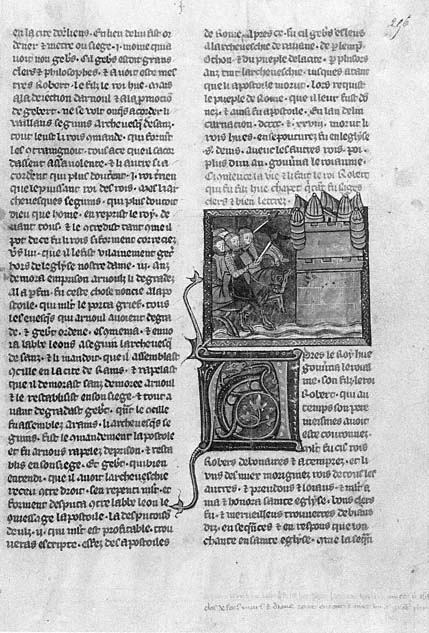
Figure 22
Knights approach a castle. Grandes Chroniques de France . Bibliothèque
Nationale, Ms. fr. 10132, fol. 256. Photograph: Bibliothèque Nationale, Paris.
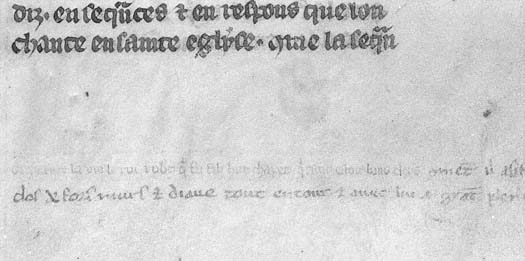
Figure 23
Notes to the illuminator and rubricator. Grandes Chroniques de France . Bibliothèque Nationale,
Ms. fr. 10132, fol. 256. Photograph: Bibliothèque Nationale, Paris.
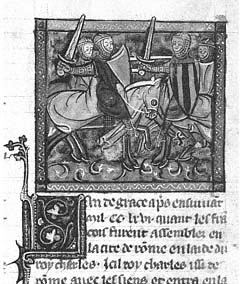
Figure 24
Battle of Charles of Anjou and Manfred.
Grandes Chroniques de France .
Bibliothèque Nationale, Ms. fr. 10132, fol.
371v.
Photograph: Bibliothèque Nationale, Paris.
followed directions to the rubricator. This occurs whether the directions to the rubricator and illuminator are on facing pages (fols. 219v–20 and 240v–41) or on the recto and verso of one folio (fols. 252–52v and 255–55v).
Most miniatures in Thomas's manuscript are essentially schematic compositions. The treatment of pictures showing battles exemplifies the way in which the artist who followed the marginal notes tailored these stock scenes to fit various situations. The battle of Manfred and Charles of Anjou (Fig. 24) represents the basic composition—a confrontation between a king and a knight on ground defined by hillocks made of black and white swirls. Artists could add details to this basic image. Extra knights and portions of dismembered bodies appear in the battle of Charles of Anjou against Conradin and Henry of Spain (Fig. 25); in a miniature painted by this artist in a later copy of the Grandes Chroniques (Castres, B.M.) trees fill in the representation of a preliminary skirmish before the battle of Bouvines (Fig. 26), and a complement of knights aid Philip Augustus in that battle (Fig. 27). Although none of the instructions for these specific pictures survive, it is quite likely that the directions given the artist for each of these miniatures specified the representation of a battle and that he adapted a stock scene to fill the need.[36]
The relation between the content of the illuminations and the rubrics that act as explanatory captions is revealing as well. When directions to the illuminator are present, pictures never depend exclusively on the rubric; in fact, in 17 of the 19 cases where directions to the illuminator survive, the rubric is very
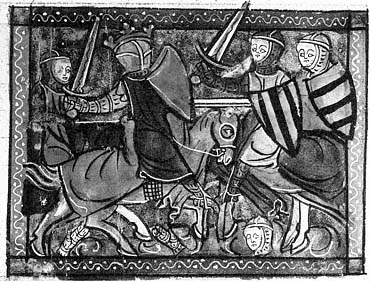
Figure 25
Battle of Charles of Anjou against Conradin and Henry of Spain.
Grandes Chroniques de France . Bibliothèque Nationale, Ms. fr.
10132, fol. 372. Photograph: Bibliothèque Nationale, Paris.
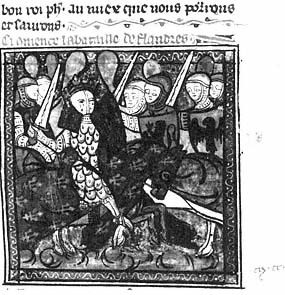
Figure 26
Battle of Bouvines. Grandes Chroniques de France .
Castres, Bibliothèque Municipale, fol. 282v.
Photograph: Bibliothèque Municipale, Castres.
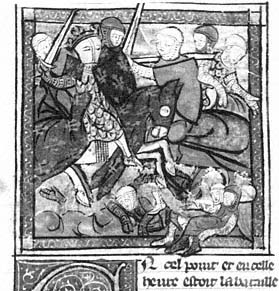
Figure 27
Capture of Ferrand. Grandes Chroniques de
France . Castres, Bibliothèque Municipale, fol. 285.
Photograph: Bibliothèque Municipale, Castres.
simple, introducing a book dedicated to the life of a king.[37] In the two cases where the rubrics are more elaborate, the pictures still follow the directions to the illuminator. However, when directions to the illuminator are absent, pictures often illustrate more elaborate rubrics that function as captions. The most obvious examples of this occur in a sequence of four rubrics in Books I–III, which provide such detailed descriptions that they could function as directions to the illuminator, although only three are illustrated in B.N. fr. 10132. These captions differ from those given in the chapter list and in such earlier copies of the chronicle as Ste.-Gen. 782. They seem to have been part of a text that circulated among Parisian libraires , because they resurfaced in a number of late fourteenth- and early fifteenth-century manuscripts of the Grandes Chroniques .[38]
Although most images in this Grandes Chroniques are composites assembled by the artist from stock compositions to illustrate written directions for "a battle," the cycle itself was carefully constructed. Indeed, the structure of this cycle of illustration differs distinctly from those that I have termed "royal" or "genealogical." The first two pictures in particular reinforce the preoccupation with dynasties exhibited in the tripartite division of text in this Grandes Chroniques . The first miniature depicts the destruction of and flight from Troy (Fig. 28). Its placement at the beginning of the prologue is rare, because the Trojan story forms part of the first chapter of Book I. A unique image derived from the iconography of the tree of Jesse (Fig. 29) displaced the Trojan image as an illustration for the first book of the chronicle. It shows a recumbent king from whom grows a tree bearing fruits that are crowned and uncrowned male heads.
The rubrics for these two pictures establish a relationship between them. A rubric under the illustration of the destruction of Troy is better suited to explain the tree: "Here begins a genealogy of the dukes who reigned before there was any king in France, and then, of the kings who reigned after them."[39] The image of the tree of descent shows the uncrowned heads (dukes) and crowned heads (kings) forming part of the same tree. Its rubric alludes to the destruction: "Here begins a genealogy of the kings of France and how they descended first from those who fled Troy."[40] The displacement of the Trojan scene to include the tree of descent at the beginning of Book I emphasizes the importance to this book of the length of the French line. This unique combination of text and image reflects the special concern with genealogy and succession outlined in the prologue of the Grandes Chroniques , a preoccupation reinforced by the introductory materials (fols. 1–6v) added to this manuscript to clarify its division into three parts.
The treatment of the reditus provides one of the most telling examples of how the perspective of Thomas of Maubeuge and Pierre of Neufchâtel, his patron, on the reading and picturing of history differed from that represented in the first version of the Grandes Chroniques .[41] In Philip III's Grandes Chroniques the reditus provides the underlying structural principle for the whole cycle. Pictures of Charlemagne and of Philip Augustus are of large scale, and textual references connect the two in a complex interrelationship. The expression of the reditus and the implications for French legitimacy of the return of government to descendants of Charlemagne were important to both the abbey of Saint-Denis and to Philip III.
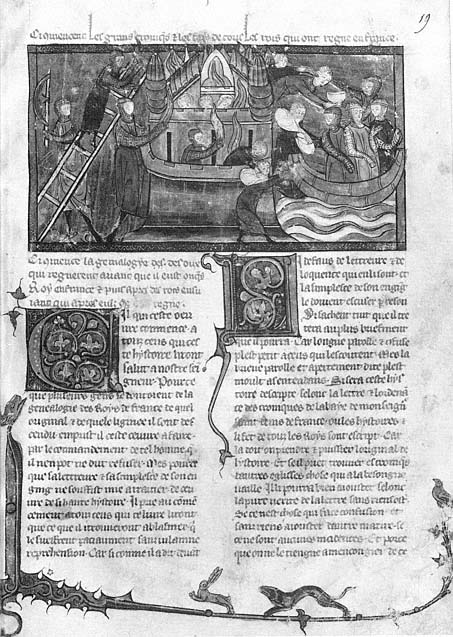
Figure 28
Destruction of Troy. Grandes Chroniques de France . Bibliothèque Nationale, Ms. fr.
10132, fol. 19. Photograph: Bibliothèque Nationale, Paris.
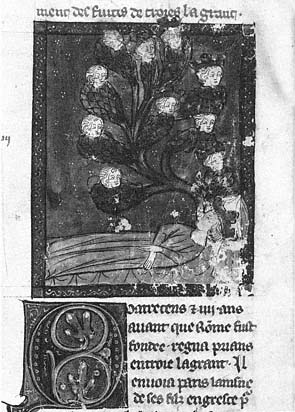
Figure 29
Tree of descent. Grandes Chroniques de France .
Bibliothèque Nationale, Ms. fr. 10132, fol. 20v.
Photograph: Bibliothèque Nationale, Paris.
The reditus is not an important concept in the Grandes Chroniques directed by Thomas of Maubeuge. In this manuscript the life of Hugh Capet, in which the reditus is first mentioned, is illustrated by a rare scene of the marriage of Philip Augustus and Elizabeth of Hainaut (Fig. 30), the deed by which the reditus was accomplished. Because this image is unusual, a reader might interpret it as a deliberate visualization of a political prophecy. Nothing could be further from the truth. Indeed, this seemingly innovative picture was the easiest way to illustrate the text that follows it. As the first event described in the chapter to lend itself to visual formulation, the marriage of Philip and Elizabeth found its way into the list of directions to the illuminator, where it is described, "How the king marries a woman and several knights and many clergy are there."[42]
The text and image for the life of Louis VIII in the manuscript commissioned from Thomas of Maubeuge support this interpretation of the reditus miniature. The official life of Louis VIII preserved in contemporary manuscripts of the
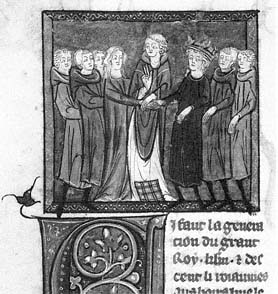
Figure 30
Marriage of Philip Augustus and Elizabeth of
Hainaut. Grandes Chroniques de France .
Bibliothèque Nationale, Ms. fr. 10132, fol. 255v.
Photograph: Bibliothèque Nationale, Paris.
Grandes Chroniques includes an extended celebration of the reditus .[43] The continuation employed by Thomas of Maubeuge in this Grandes Chroniques plays down the prophecy, and the illustration of the chapter ignores it, representing Louis VIII receiving a messenger.[44]
A consideration of pictures that depart from the traditional layout followed in this manuscript (in which a miniature begins each book of the chronicle) makes clear what themes attracted either Thomas of Maubeuge or Pierre of Neufchâtel. Nine pictures subdivide books in this copy of the Grandes Chroniques .[45] These reveal interest in such heroes of French history as Clovis, Dagobert, and Pepin and demonstrate a desire to document Charlemagne's acquisition of relics that, at the time of this manuscript's execution, were thought to be kept at Saint-Denis.
In summary, what is most important about Pierre of Neufchâtel's Grandes Chroniques is the insight it provides into popular cycles of the chronicle. Both the pictorial cycle and the textual organization of this manuscript are very different from contemporary Dionysian, royal, and courtly programs. Thomas of Maubeuge was the only editor to be faithful to the division of the texts outlined in the prologue of the Grandes Chroniques and to attempt in the first few illustrations of the program to reinforce the prologue's dynastic message. Both the organization of the text and the paired introductory miniatures in this copy of the chronicle concentrate on the succession of the three races of French kings. Although the
rest of the cycle is less innovative, it is nonetheless an important source for examining aspects of the history that interested the broader audience who bought manuscripts from libraires . This chronicle manifests less concern with questions of dynastic succession than preoccupation with traditional French heroes. Unlike many royal and courtly manuscripts of the Grandes Chroniques , which were tied closely to royal self-perception and to the changing political situation in France, such apolitical manuscripts as that commissioned from Thomas of Maubeuge retained their popularity through the reigns of the early Valois.[46]